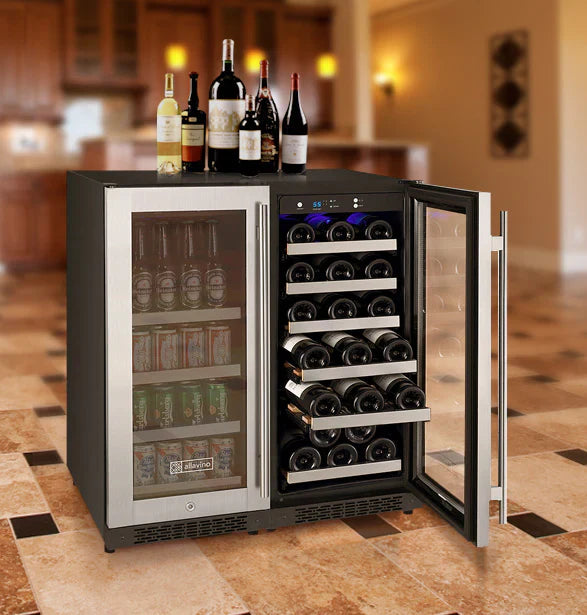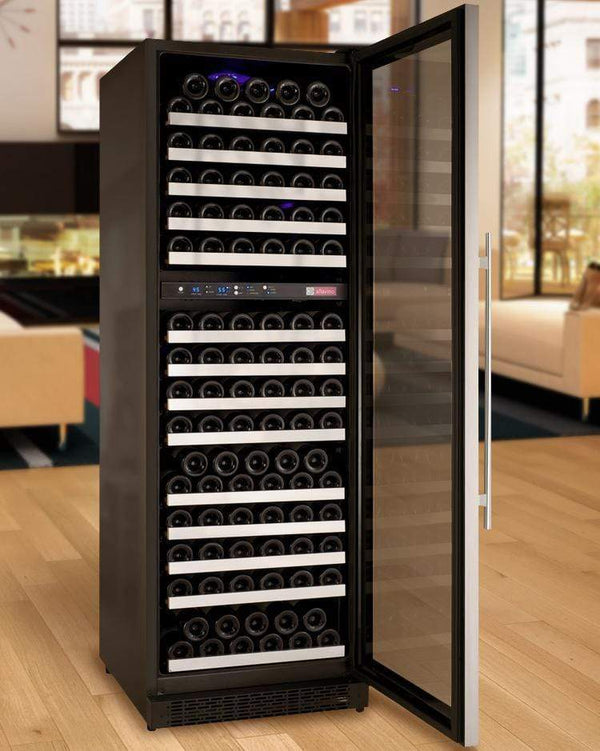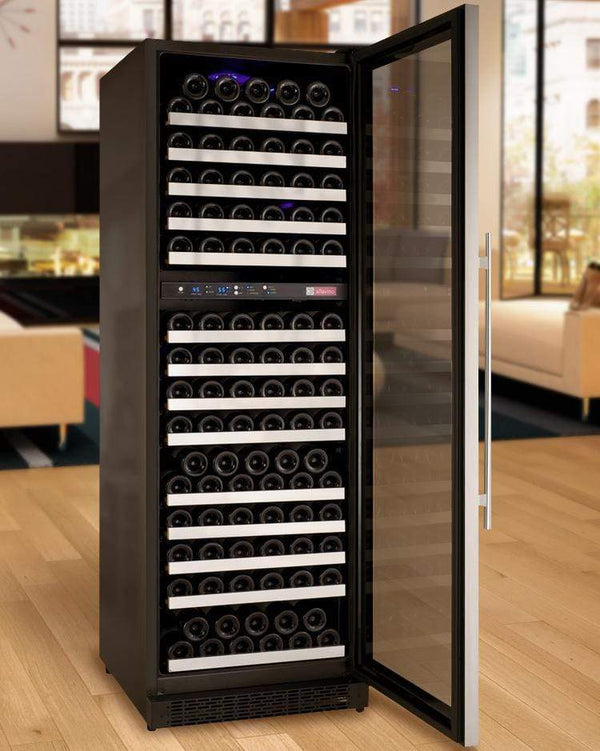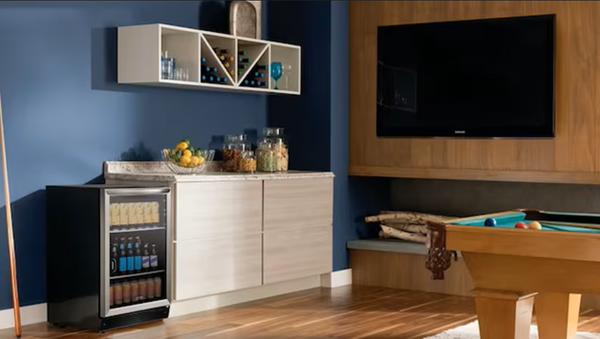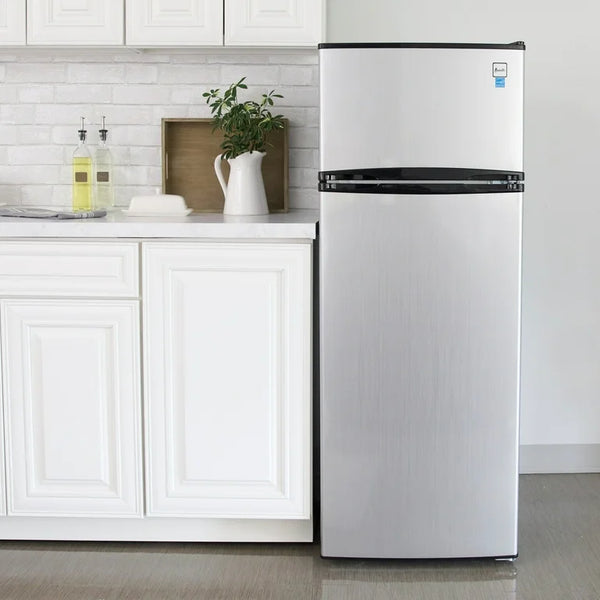Designing a Wine Cellar?
Let’s get it right.
Our specialists review your room layout, insulation, and heat load to recommend the correct cooling system for stable temperature and reliable climate control.
Ultimate Wine Racks Buying Guide: Styles & Sizing Tips
🧭 Feeling Overwhelmed by Wine Rack Options? Let’s Simplify It
By Jim Hopper, Wine Cooling Expert

Your wine deserves more than a shelf — it deserves a proper home.
Whether you collect wine for celebration, investment, or sheer enjoyment, the right wine rack enhances not just your storage — it reflects your taste, your lifestyle, and your long-term goals.
This guide will walk you through everything you need to confidently choose the perfect wine rack: type, size, material, placement, and buying pitfalls. Let’s make this decision easy, stylish, and smart.
🍷 Why Use a Wine Rack? The Key Benefits
Owning a wine rack offers more than just a place to stash bottles — it’s an essential tool for anyone who wants to care for their collection and enjoy wine at its best. Here’s why:
- Organization: Keep your entire collection in one easily accessible location, rather than scattered around your home.
- Proper Preservation: Most wine racks store bottles horizontally, keeping corks moist and preventing premature aging or spoilage.
- Efficient Use of Space: Wine racks are designed to maximize storage, making even small spaces work for growing collections.
- Attractive Display: Showcase your bottles as part of your home décor, turning your wine into a visual feature.
- Easy Access: Organized racks make it simple to see labels and quickly find the right bottle for any occasion.
- Protection from Vibration: A stable rack protects wine from harmful vibrations that can disturb sediment and affect flavor.
Whether you’re a casual drinker or a serious collector, these benefits help your wine stay organized, age gracefully, and look great in any setting.
🧱 Types of Wine Racks and How They Work

Wine racks come in a variety of styles, each designed to meet different needs for space, design, and function. Here's an overview of the most popular types and where they shine. If you’re looking for a deeper breakdown by layout and features, check out our guide on types of wine racks.
Want a deeper dive into each style? Explore our Types of Wine Racks guide for comparisons and inspiration.
🛠️ Custom & Built-In Wine Racks
If you have a unique space or want a seamless, high-end look, consider custom or built-in wine racks. These solutions are tailored to your home’s dimensions and style, making use of under-stair areas, niches, or cabinetry.
- Benefits: Perfect fit, maximizes awkward spaces, matches your decor.
- Considerations: Higher upfront cost, requires professional installation, and is usually permanent.
Custom racks are ideal for serious collectors or anyone looking to create a statement wine room.
Wall-Mounted Wine Racks
These racks attach directly to the wall, saving floor space while creating a stylish focal point. For more on why wall-mounted racks are a smart choice, read The Benefits of Wall-Mounted Wine Racks. They're ideal for kitchens, dining rooms, or minimalist cellars. For more design and installation tips, explore our article on wall-mounted wine racks.
Freestanding Wine Racks
Standalone units that range from compact to massive. Ideal for basements, wine rooms, or formal displays.
Modular Wine Racks
Expandable, customizable, and perfect for evolving collections.
Countertop Wine Racks
Compact, decorative, and designed for convenience.

Comparison Table: Wine Rack Types
| Type | Best For | Pros | Cons |
|---|---|---|---|
| Wall-Mounted | Style & space-saving | Sleek, decor-friendly | Requires secure installation |
| Free-standing | Large collections | High capacity, no install needed | Requires floor space |
| Modular | Growing collections | Expandable, flexible | Some assembly required |
| Countertop | Everyday use | Easy access, compact | Limited bottle count |
📝 Quick Checklist: What Do You Need in a Wine Rack?
- How many bottles do you currently own? Will your collection grow?
- Where do you want to place your rack (wall, floor, counter, cellar)?
- What’s your home’s interior style (modern, rustic, minimalist, luxury)?
- Do you want a permanent or flexible solution?
- Is your priority storage, display, or both?
- Do you need to store different bottle sizes (Champagne, magnums)?
Jotting down your answers will help narrow your choices and avoid buyer’s remorse.
🪵 Choosing the Right Wine Rack Material

The material of your wine rack plays a major role in how it performs, looks, and lasts over time. If you’re deciding between natural warmth or modern durability, our wood vs metal wine racks guide dives into which is best for your space.
See our full comparison in Wood vs Metal Wine Racks.
Wood
Warm and traditional, wood racks are ideal for classic or rustic interiors.
Metal
Modern, slim, and space-efficient. Works well in urban or minimalist spaces.
Acrylic or Glass Hybrids
Sleek and luxurious, great for statement installations or retail settings.

🎨 Style Tip: Match Material to Room Style
| Room Style | Ideal Material |
|---|---|
| Rustic | Reclaimed or stained wood |
| Modern | Matte black or brushed steel |
| Industrial | Raw metal + unfinished wood |
| Luxury | Acrylic + backlighting |
📏 How to Size Your Wine Rack: Bottle Count & Future Growth

A wine rack isn’t just about how many bottles you have now — it’s about how your collection will grow. If you need a step-by-step tutorial with measuring diagrams, visit our how to measure for a wine rack guide.
Use our wine rack bottle capacity guide to determine your actual need, now and in 12 months. For a detailed breakdown of bottle capacities by rack type and expert tips on planning for growth, see our Wine Rack Bottle Capacity Guide.
Step 1: Count Your Bottles and Project Forward
Estimate your current number of bottles and how many you expect to acquire in the next 6–12 months.
Step 2: Measure Your Available Space
Don’t forget to include height, width, depth, and clearance for pulling bottles in and out.
Need step-by-step instructions? Our How to Measure for a Wine Rack guide walks you through the process with diagrams and pro tips.
Step 3: Know Your Bottle Types

| Bottle Type | Volume | Notes |
|---|---|---|
| Standard | 750ml | Fits most racks |
| Champagne | 750ml | Often wider |
| Magnum | 1.5L | Needs larger slots |
| Burgundy | 750ml | May not fit tight slots |
📐 Quick Reference: Standard Bottle & Rack Dimensions
| Bottle Type | Typical Size (L × D) | Minimum Slot Diameter | Minimum Rack Depth |
|---|---|---|---|
| Standard (750ml) | 12" × 3.2" | 3.5" | 12–14.5" |
| Champagne | 12" × 3.5"–3.75" | 4" | 14.5" |
| Magnum (1.5L) | 14" × 4" | 4.25" | 14.5" |
| Split (187ml) | 7.5" × 2.5" | 2.75" | 7–10" |
Always check that your chosen rack can accommodate the largest bottles in your collection.
Step 4: Plan to Expand
Choose modular or stackable racks so you can grow your collection over time.
Single-Deep vs. Double-Deep Racks:
Single-deep racks store bottles in a single row, making each bottle easy to access. Double-deep racks allow you to store two bottles back-to-back in the same row—doubling capacity in the same footprint, which is ideal for larger collections or maximizing space in cellars and closets.
Wine Rack Dimensions & Bottle Sizes: What You Need to Know
When selecting a wine rack, matching the rack’s dimensions to your bottle sizes is crucial for both fit and function. Here are standard guidelines to ensure your bottles are stored safely and accessibly:
-
Rack Depth: Most standard racks are 12–14.5 inches deep. This accommodates a standard 750ml bottle (about 12" long), storing it fully supported and horizontally.
- For open racks, a depth of around 7 inches can work, but make sure bottles won’t protrude or be unstable.
- Slot Diameter: Standard rack openings are 3.2–3.5 inches, fitting most 750ml bottles. If you plan to store Champagne, Burgundy, or magnum bottles, look for racks with 4–4.25 inch openings.
- Bottle Clearance: Ensure there’s enough space above each slot or shelf to easily pull bottles in and out—especially for larger formats.
Quick Reference Table:
| Bottle Type | Typical Size (L × D) | Recommended Slot Diameter | Recommended Rack Depth |
|---|---|---|---|
| Standard (750ml) | 12" × 3.2" | 3.5" | 12–14.5" |
| Champagne | 12" × 3.5–3.75" | 4" | 14.5" |
| Magnum (1.5L) | 14" × 4" | 4.25" | 14.5" |
| Split (187ml) | 7.5" × 2.5" | 2.75" | 7–10" |
If you have a mix of bottle shapes, choose a rack with slightly larger openings or adjustable shelves.
Real-World Capacity Examples
To help you visualize what fits in your space, here are some typical capacities for common rack types:
- A single-deep floor-to-ceiling rack (for an 8-foot ceiling) can hold about 60–70 bottles.
- Double-sided or double-deep racks can store over 100 bottles in the same height.
- Wall-mounted racks often range from 6 to 24 bottles, depending on length and design.
- Countertop racks typically hold 2–12 bottles—perfect for kitchens and bars.
Remember: Always check the manufacturer’s specs and measure your space before purchasing.
📍 Where Should You Place Your Wine Rack?

Choosing the right location matters. Your wine should be stored in a place that’s stable in temperature and protected from light and vibration.
Best Locations:
- Dining room wall
- Climate-controlled cellar
- Pantry with passive cooling
- Under-stair alcove
- Kitchen (away from heat)
Need help maximizing a tight footprint? Check our guide to the best wine racks for small spaces. Discover more space-saving solutions in our Best Wine Racks for Small Spaces article.
Locations to Avoid:
- Direct sunlight
- HVAC vents
- Kitchen appliances
- High-traffic areas
Use Case: A Denver couple used a ducted cooling unit with a wall-mounted modular rack beneath their stairs — creating a stylish, silent cellar zone.
🍇 Essential Wine Storage Conditions
To protect your wine’s flavor and aging potential, it’s important to consider more than just rack style. No matter which rack you choose, pay attention to these storage basics:
- Temperature: Aim for a stable environment around 55°F (13°C). Fluctuations or high heat can harm your wine.
- Humidity: Keep humidity between 60–70% to prevent corks from drying out or developing mold.
- Light: Store wine away from direct sunlight and strong artificial light, which can degrade flavors.
- Vibration: Avoid placing racks near appliances or areas with frequent movement, as vibrations can disturb sediment.
- Odors: Strong smells from paints or cleaning products can seep through corks and affect your wine’s aroma.
Following these guidelines will help ensure your collection matures gracefully, whether you’re storing a few bottles or a full cellar.
✔️ Buying Tips & Mistakes to Avoid

Top Tips
- Always buy larger than your current bottle count
- Double-check dimensions — especially wall height and bottle neck clearance
- Consider mix of bottle types (Champagne, Burgundy, magnums)
- Choose style AND strength (especially for wall-mounted options)
Common Mistakes (and Why They Matter)
- Ignoring installation requirements: Wall-mounted racks must be anchored securely; otherwise, bottles could fall.
- Underestimating collection growth: Many buyers fill their racks within months and need to buy again—plan for expansion.
- Forgetting about humidity and temperature: Storing wine in a hot, dry kitchen may ruin corks and flavors.
- Buying based on looks alone: A beautiful rack that doesn’t fit your bottle sizes or space will cause frustration.
Thinking about building or hiring a carpenter? Read our guide on DIY vs custom wine racks to weigh cost vs quality.
Learn more in our DIY vs Custom Wine Racks article.
Further Reading:
- New Ways to Display Wine Racks
- Best Wine Racks for Wine Cellars
- Introducing Ultra Wine Racks & Cellars
- How to Organize a Wine Cellar
📞 Call to Action

👋 Got questions? Need help choosing the right wine cooling system for your space?
Our experts at Wine Coolers Empire are here to guide you.
📞 Call us today at 1-888-407-7770 for your FREE Cooling Consultation!
📧 Or email us at support@winecoolersempire.com — we’re happy to help.
🛒 Shop Wine Cooling Systems at Wine Coolers Empire
📚 Frequently Asked Questions (FAQs)
What size wine rack do I need?
Is wood or metal better for wine racks?
Can I put a wine rack in the kitchen?
Do wine racks need ventilation?
Can wine racks damage wine?
What’s the difference between a wine rack and a wine cellar?

Designing or Upgrading a Wine Cellar?
We got you! Here at Wine Coolers Empire, we will guide you in building your dream wine cellar.




